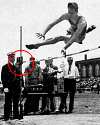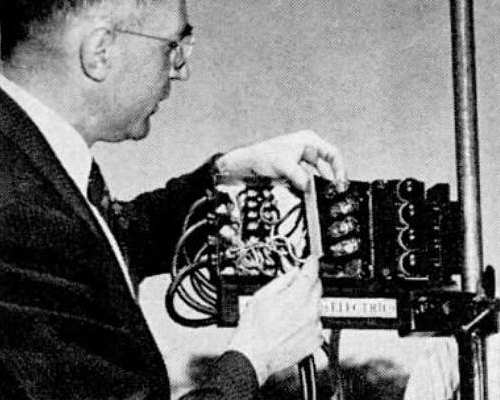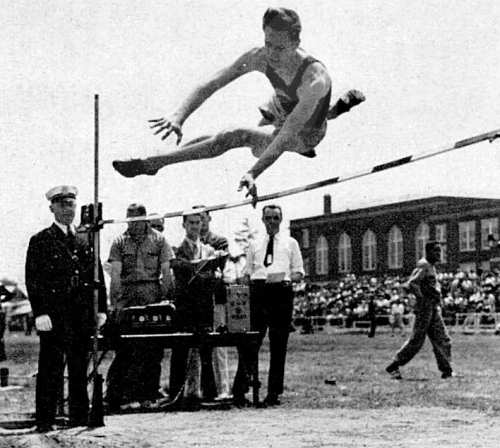
|
High Jump Measured by Electric Eye Detector
(31 May 1941)
First used at an interscholastic track meet in Schenectady, N. Y.
|
Electric Eyes Speed Up High Jump by Measuring Mark Set Exactly
from Popular Science
(1941)
The electric eye was used to speed up high-jumping at a recent track
meet of the Schenectady, N. Y., Patrolmen's Association, by measuring
the height of each jump exactly, almost regardless of the height of
the pole. The equipment, designed by General Electric engineers,
comprises a movable light source on one standard and four electric
eyes on the other, with a box which operates the equipment and records
the height jumped. Four parallel beams, an inch apart, are focused
between the standards, so that if a jumper goes higher than the set
mark, he is credited with the additional height up to three inches. In
place of the usual bamboo pole, a narrow strip of paper is stretched
along the path of the lowest beam to guide the jumper. The Amateur
Athletic Union, under whose auspices the meet was held, approved the
equipment.

These four electric
eyes, set an inch apart, give the jumper credit for jumps above the set
mark. Another advantage is that the light beams do not sag as do the
usual bamboo poles.
Text and photos from
Popular Science (Sep 1941), 112
(source).
See also:
 31 May
- short
biography, births, deaths
and events on date of first use of electric eye high jump detectors.
31 May
- short
biography, births, deaths
and events on date of first use of electric eye high jump detectors.
Nature bears long with those who wrong her. She is patient under abuse. But when abuse has gone too far, when the time of reckoning finally comes, she is equally slow to be appeased and to turn away her wrath. (1882) --
Nathaniel Egleston, who was writing then about deforestation, but speaks equally well about the danger of climate change today.
 Carl Sagan
Carl Sagan: In science it often happens that scientists say, 'You know that's a really good argument; my position is mistaken,' and then they would actually change their minds and you never hear that old view from them again. They really do it. It doesn't happen as often as it should, because scientists are human and change is sometimes painful. But it happens every day. I cannot recall the last time something like that happened in politics or religion. (1987) ...
(more by Sagan) Albert Einstein: I used to wonder how it comes about that the electron is negative. Negative-positive—these are perfectly symmetric in physics. There is no reason whatever to prefer one to the other. Then why is the electron negative? I thought about this for a long time and at last all I could think was “It won the fight!” ...
(more by Einstein) Richard Feynman: It is the facts that matter, not the proofs. Physics can progress without the proofs, but we can't go on without the facts ... if the facts are right, then the proofs are a matter of playing around with the algebra correctly. ...
(more by Feynman)



 31 May
- short
biography, births, deaths
and events on date of first use of electric eye high jump detectors.
31 May
- short
biography, births, deaths
and events on date of first use of electric eye high jump detectors.



